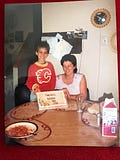Can sports rivalries bring us closer together?
Issue 50: On the Battle of Alberta; what economics can gain from understand identity; how identity fosters belonging in organizations.
Jay was eight years old when he learned about the nature of social identity.
On the school intercom one morning in late April 1986, his teachers announced that every student in his elementary school should come to school wearing either blue and white to represent the Edmonton Oilers or red and yellow to represent the Calgary Flames. It was the eve of Ga…
Keep reading with a 7-day free trial
Subscribe to The Power of Us to keep reading this post and get 7 days of free access to the full post archives.


